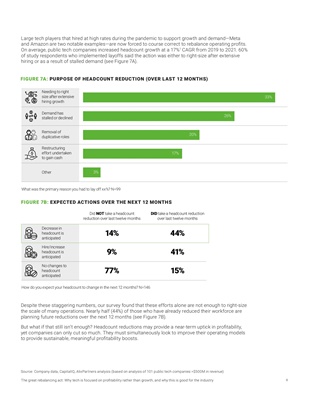
The great rebalancing act: Why tech is focused on profitability rather than growth, and why this is good for the industry 8
Large tech players that hired at high rates during the pandemic to support growth and demand-Meta
and Amazon are two notable examples-are now forced to course correct to rebalance operating profits.
On average, public tech companies increased headcount growth at a 17%1 CAGR from 2019 to 2021. 60%
of study respondents who implemented layoffs said the action was either to right-size after extensive
hiring or as a result of stalled demand (see Figure 7A).
Despite these staggering numbers, our survey found that these efforts alone are not enough to right-size
the scale of many operations. Nearly half (44%) of those who have already reduced their workforce are
planning future reductions over the next 12 months (see Figure 7B).
But what if that still isn't enough? Headcount reductions may provide a near-term uptick in profitability,
yet companies can only cut so much. They must simultaneously look to improve their operating models
to provide sustainable, meaningful profitability boosts.
How do you expect your headcount to change in the next 12 months? N=146
What was the primary reason you had to lay off xx%? N=99
Needing to right
size after extensive
hiring growth
Removal of
duplicative roles
Restructuring
effort undertaken
to gain cash
Other
Demand has
stalled or declined
FIGURE 7A: PURPOSE OF HEADCOUNT REDUCTION (OVER LAST 12 MONTHS)
33%
26%
20%
17%
3%
Did NOT take a headcount
reduction over last twelve months
DID take a headcount reduction
over last twelve months
Hire/increase
headcount is
anticipated
No changes to
headcount
anticipated
Decrease in
headcount is
anticipated 14% 44%
9% 41%
77% 15%
FIGURE 7B: EXPECTED ACTIONS OVER THE NEXT 12 MONTHS
Source: Company data, CapitalIQ, AlixPartners analysis (based on analysis of 101 public tech companies >$500M in revenue)